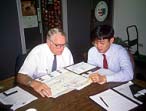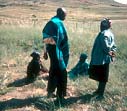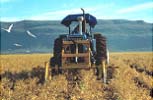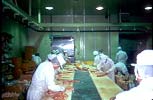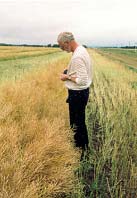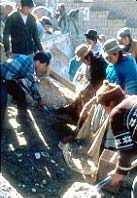April 2005 // Volume 43 // Number 2 // Commentary // 2COM2
Lessons Learned Abroad
Abstract
American Extension has left its footprints
overseas for more than 50 years. An experienced Extension internationalist
reflects on how lessons learned abroad find expression in a more global but
vulnerable homeland today.
Background
For decades, land-grant university Extension workers have made their way to the far reaches of the world to participate in a variety of agricultural, rural family, trade, and development activities. These efforts have been funded by several sources, principally agencies of the U.S. Government, such as USDA, FAS, and USAID. Non-governmental organizations have likewise been important sources of development and relief funding overseas and have engaged seasoned Extension workers in the implementation of projects worldwide.
Those agencies and organizations have made productive use of land-grant outreach personnel because their own goals and objectives as well as their target clienteles were consistent with the world of professional Extension. Otherwise stated, agriculture, rural family life, consumer affairs, youth education, natural resource allocation, community development, and trade among peoples who seek to better their lives through knowledge and improvement is the world of professional Extension.
During the long tenure of American involvement overseas, much of the traditional thrust was the attempted transfer of U.S. Extension methodology to venues offshore. The assumption was that if a practice was successful at home, it would most certainly work abroad. Sometimes that turned out to be indeed the case.
But, at other times, American efforts failed miserably. They failed, most likely, because a parallel assumption that human behavior was culturally unconditional was simply not the case. While the basic needs of food, shelter, and subsistence income were somewhat universal, as were notions of joy, grief and fear, almost every human activity and value associated with those aspects of life turned out to be profoundly cultural. Even the perceptions of poverty and wealth differed remarkably from place to place.
Transformation
It was not until the early 1980's that American development personnel began to really "listen" to host nationals, and even then the ideas of technology transfer, trickle-down economics, and other constructs continued to persist. But gradually, experienced and sensitive development workers began to prevail in their advocacy of farming systems research that commenced to harness knowledge and involve aid recipients in decision making. At that time also, the "women in development" movement found a home in foreign assistance philosophy, thus tapping the talent, wisdom, and energy of more than half the world's population. Significant discovery!
Training-and-visit strategies began to emerge from South Asia that centered on intensified training of large cadres of Extension ranks in timely or pressing subject matters, followed by immediate implementation of strategies learned, followed by more intensive training on subsequent pressing problem issues, and so on. Today in development circles, notions of social marketing and community mobilization are widely discussed.
As time goes on, models emerge, experiments are launched, methodologies are developed and implemented, and nomenclatures wax and wane. In all of these dynamics, the one constant is change! The world changes. Peoples' needs change. Problems change. Available resources change.
In any Extension methodology, there are useful elements and others that are probably short-lived if they work at all. An over-riding rule of survival in international Extension work is to involve clients as equal partners in the task at hand, identifying issues through their eyes and values and implementing what works. Then, get rid of what doesn't work, no matter who thinks it's a great idea! Common sense is the best Extension tool in all this. And common sense is a rather pervasive international language.
Transition
It is likely not enough for American Extension workers to have implemented some of these principles successfully during their tenure abroad, to have concluded their assignments on a high note, and to have perhaps made a lasting difference in some corner of the world. Invariably, those same workers then returned to duties as usual in the U.S. and got on with their professional lives wherever they left off at earlier times. The difference between earlier times and now is that the U.S. has changed.
The issue here is not the gradual change that always takes place across the land with economic fluctuations, emerging cropping patterns, evolving family configurations, population displacements, and consumer trends. A whole new factor has now entered on the American scene, that of security. Oh, some Americans have always known a degree of economic insecurity and even personal insecurity in certain situations. But national insecurity is new to America, especially homeland insecurity.
At the same time, Extension professionals must face the same problem-solving challenges they always face in roughly the same traditional areas of endeavor, but in a remarkably less secure country! So, among the lessons to be learned from all those years of service abroad is that the clients and associates remembered from projects in places like southern Asia, eastern Europe, Latin America, the Middle East, or parts of Africa more than likely faced similar insecurity their entire lives. Yet, together with those Americans who worked beside them, they prevailed in their tasks despite that insecurity. And so must we.
Since 9/11, Americans have experienced widespread paranoia. Whoever we are, we have now been influenced and even encouraged to look with suspicion upon persons unlike ourselves (whatever it is that we are supposed to look like). Those are not the values that built America. They are not the values that will rebuild America. And they are certainly not the values that will sustain productive extension work. Let us remember that people in Palestine, Israel, and other Middle Eastern areas, as well as in Colombia and several African nations live in personal danger constantly. Yet they get on with the business of their lives each day with the resourcefulness they can muster. And, believe it or not, Extension work takes place in those countries every day as well.
Application
Looking at the legacy of American Extension work abroad, the lessons learned are legion, and many can be applied to a changing and even uncertain homeland scenario today. Extension workers are fewer than in earlier times, and problems are more complex. But fortunately, clients are many times more informed and largely more aware. It is imperative that clients become partners in problem solving, or problems will likely remain unsolved.
Indigenous knowledge simply should be heard and incorporated into the dynamic or a truly valuable resource will be negated. Inclusion of community volunteers becomes an increasingly vital resource in Extension work, not only as helping hands but also as managers and instructors. Citizen empowerment and action worked abroad, and it works at home. And in all this, nobody's gift is too small.
On a similar track, memories from overseas recall many traditional, folk, cultural, and religious organizations and social configurations that proved to be useful program vehicles for Extension work. Certain similarities are found in American community groups. Prominent among these are the churches and faith-based organizations. Extension in the U.S. has come far from the days when the church-state separation created some sort of razor-wire barrier to effective programming.
Today, many priests, pastors, and congregational groups can be welcome partners and collaborators in Extension work, especially in reaching ethnic and new immigrant audiences. Likewise, new and fertile Extension ground is to be found in Islamic, Buddhist, Jewish, Native American, and other cultural and religious realms where traditional Extension has had limited prior success. Festive, ethnic, and cultural celebrations are also offering open doors to Extension workers willing to be engaging in their personal outreach.
In recent years, Extension made its presence felt with its participation in foreign trade. Washington State University may possibly have pioneered the role of Extension Trade Specialist attached to its own international trade development center (IMPACT). The involvement of that specialist and a cadre of colleagues in some 28 export destinations of the world brought lessons learned abroad home to a grower/producer clientele in a very dramatic way.
Being on the ground in the marketplace, interacting with offshore buyers and consumers, was a landmark achievement for Extension and for home state exporters. An additional bonus was the array of valuable insights into how foreign traders trade, how overseas buyers evaluate commodities, how offshore retailers value products, and how consumers around the world actually prepare and consume food items grown in Oregon or Minnesota or Georgia.
It may seem there would be little to learn from abroad about "women in development" by Extension workers in the country that probably coined the terminology. Yet examples of the high profile of American women in the direct marketing and farmers' market activity seen across the U.S. landscape today recall all too distinctly images of women in village markets of Cameroon or the tanguis of Mexican ejidos. The counterpart of women's community savings and loan schemes in Appalachia can be seen even earlier in rural Bangladesh. And women's weaving and handicraft coops in trendy American university communities have antecedents in rural Bolivia and Lesotho. And there were Extension workers involved in their inception.
The list goes on in other realms of professional Extension work.
-
Agriculturalists have returned from abroad to engage in the propagation and cultivation of ancient crops seen perhaps for the first time in foreign lands. Now acreages of spelt, teff, millet, and red lentil extend across the American landscape.
-
Extension staff who have worked with youth in Latin America and Asia have returned from lands whose population is grossly juvenile to a U.S. in which a traditional population is graying while a youth boom is occurring among a burgeoning Hispanic community.
-
Natural resource Extension workers have seen denudation and devastation on a vast scale in some offshore locations and have returned to find alarmingly similar mistakes being made at home in the name of economic growth.
-
Family/consumer Extension professionals have gained new insights into the stark realities of absentee male populations and reverse gender roles being played out in some world regions, while at the same time discovering delightfully wonderful and fulfilling grandmothering profiles in action. But they have also witnessed the grinding desperation of sweatshop garment manufacture for American showrooms.
-
Finally in community development, the apex of lessons to be learned must certainly be found among the indigenous Andean communities where communal labor is expected, the common good is valued, and shared property is the norm.
Outlook
In summary, it might be said that the world has become a remarkably small place. Extension work is very important in collective efforts to resolve problems of human, resource, production, consumer, and societal dimensions. Americans have become increasingly exposed to the world and have been involved in sharing development efforts internationally. They have learned many things that, without exception, have application at home. In today's world of global and national insecurity, the question remains as to whether or not American Extension workers have learned the most valuable lesson of all. The world itself is the ultimate, finite resource. There are no we and they. There are only we.
|
|
|
|
|
|
|
|

